string内建函数
1 字符串内建函数
1.1 转换类函数
'''
字符串内建函数
capitalize():将字符串第一个字母转换为大写字母
title():将每个单词的首字母大写
upper() :将字符串全部转换为大写
lower():将字符串全部转换为小写
istitle():方法检测字符串中所有的单词拼写首字母是否为大写,且其他字母为小写。
如果字符串中所有的单词拼写首字母是否为大写,且其他字母为小写则返回 True,否则返回 False.
'''
1 import random 2 3 message='this is a beautiful city' 4 5 msg=message.capitalize() 6 7 print("%s--message.capitalize()="%message,msg)#将字符串第一个字母转换为大写字母 8 9 msg=message.title() 10 11 print("%s--message.title()="%message,msg)#将每个单词的首字母大写 12 13 result=msg.istitle() 14 15 print("%s--message.istitle()="%message,result)#检测字符串中所有的单词拼写首字母是否为大写,且其他字母为小写。 16 17 msg=message.upper()#将字符串全部转换为大写 18 19 print("%s--message.upper()="%message,msg) 20 21 msg=message.lower()#将字符串全部转换为小写 22 23 print("%s--message.lower()="%message,msg)

1 #随机生成4个验证码 2 3 s='ABCDEFGHIJKLMNOPQRSTUVWXYXZabcdefghijklmnopqrstuvwxyz0123456789' 4 5 print(len(s)) 6 7 code='' 8 9 for i in range(4): 10 11 ran=random.randint(0,len(s)-1) 12 13 code+=s[ran] 14 15 16 17 print(code) 18 19 #输入验证码成功则提示输入正确,错误则提示错误 20 21 user_input=input('请输入验证码:') 22 23 if user_input.lower()==code.lower(): 24 25 print('验证码输入正确') 26 27 else: 28 29 print("验证码输入错误")
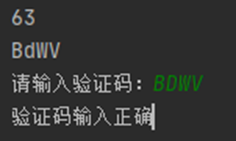
1.2 查找类函数
'''
查找相关
find():方法检测字符串中是否包含子字符串 str ,如果指定 beg(开始) 和 end(结束) 范围,
则检查是否包含在指定范围内,如果包含子字符串返回开始的索引值,否则返回-1。
str.find(str, beg=0, end=len(string))
参数
str -- 指定检索的字符串
beg -- 开始索引,默认为0。
end -- 结束索引,默认为字符串的长度。
rfind():从右侧检索位置, 返回字符串最后一次出现的位置,如果没有匹配项则返回 -1。
str.rfind(str, beg=0 end=len(string))
参数
str -- 查找的字符串
beg -- 开始查找的位置,默认为 0
end -- 结束查找位置,默认为字符串的长度。
index():和find()一样,只是找不到会报异常
str.index(str, beg=0, end=len(string))
参数
str -- 指定检索的字符串
beg -- 开始索引,默认为0。
end -- 结束索引,默认为字符串的长度。
rindex():返回子字符串 str 在字符串中最后出现的位置,如果没有匹配的字符串会报异常,
str.rindex(str, beg=0 end=len(string))
参数
str -- 查找的字符串
beg -- 开始查找的位置,默认为0
end -- 结束查找位置,默认为字符串的长度。
replace(old,new,[max]):方法把字符串中的 old(旧字符串) 替换成 new(新字符串),如果指定第三个参数max,则替换不超过 max 次。
str.replace(old, new[, max])
参数
old -- 将被替换的子字符串。
new -- 新字符串,用于替换old子字符串。
max -- 可选字符串, 替换不超过 max次
'''
1 s1='good secuqry sundy shaine' 2 3 result= 'c' in s1 4 5 print("%s---'c' in s1="%s1,result) 6 7 position=s1.find("s") #返回-1表示没找到 8 9 print("%s---s1.find('s')="%s1,position) #如果可以找到则返回字符第一次出现的位置 10 11 p=s1.find('s',position+1,len(s1)-2) 12 13 print("%s---.find('s',position+1,len(s1)-2)="%s1,p)

1 info = 'zcdfgabcadfgabcdfg' 2 3 res=info.find('dfg',10) 4 5 print("%s---info.find('dfg',10)="%info,res) # 从下标1开始,查找在字符串里第1个出现的子串:返回结果15

url='https://timgsa.baidu.com/img/timg.jpg' p=url.rfind('/') #从右侧检索位置, 返回字符串最后一次出现的位置,如果没有匹配项则返回 -1。 print("%s\turl.rfind('/')="%url,p) filename=url[p+1:] print("%s\turl[p+1:]="%url,filename) p=url.rfind('.') print("%s\turl.rfind('.')="%url,p) name=url[p:] print("%s\turl[p:]="%url,name)

1 str = "this is really a string example....wow!!!"; 2 3 substr = "is"; 4 5 print str.rfind(substr, 1, 10);

1 str='399fgdhj341fgs345' 2 3 position=str.index('fg',2,-2) 4 5 print("%s----str.index('fg',2,-2)="%str,position) 6 7 8 9 p1=str.rindex("fg",2,-2)#返回子字符串 str 在字符串中最后出现的位置,如果没有匹配的字符串会报异常, 10 11 print("%s----strrindex('fg',2,-2)="%str,p1)

1 date='2020/10/2' 2 3 方法把字符串中的 old(旧字符串) 替换成 new(新字符串),如果指定第三个参数max,则替换不超过 max 次。 4 5 print("%s---date.replace('/','-')="%date,date.replace('/',"-"))

1 str = "this is string example....wow!!! this is really string"; 2 3 res=str.replace("is", "was", 3) 4 5 print("%s---str.replace('is', 'was', 3)="%str,res) ;#thwas was string example....wow!!! thwas is really string

1.3 decode(),encode(),startswith(),endswith()
'''
字符串内建函数
encode
str.encode(encoding='UTF-8',errors='strict')
参数
encoding -- 要使用的编码,如"UTF-8"。
errors -- 设置不同错误的处理方案。默认为 'strict',意为编码错误引起一个UnicodeError。
其他可能得值有 'ignore', 'replace', 'xmlcharrefreplace', 'backslashreplace' 以及通过 codecs.register_error() 注册的任何值。
decode
str.decode(encoding='UTF-8',errors='strict')
参数
encoding -- 要使用的编码,如"UTF-8"。
errors -- 设置不同错误的处理方案。默认为 'strict',意为编码错误引起一个UnicodeError。
其他可能得值有 'ignore', 'replace', 'xmlcharrefreplace', 'backslashreplace' 以及通过 codecs.register_error() 注册的任何值。
编码:网络应用 中文设计编码解码
startswith()方法用于检查字符串是否是以指定子字符串开头,
如果是则返回 True,否则返回 False。如果参数 beg 和 end 指定值,则在指定范围内检查。
方法语法:
str.startswith(str, beg=0,end=len(string));
参数
str -- 检测的字符串。
strbeg -- 可选参数用于设置字符串检测的起始位置。
strend -- 可选参数用于设置字符串检测的结束位置。
endswith()方法用于判断字符串是否以指定后缀结尾,
如果以指定后缀结尾返回True,否则返回False。可选参数"start"与"end"为检索字符串的开始与结束位置。
方法语法:
str.endswith(suffix[, start[, end]])
参数
suffix -- 该参数可以是一个字符串或者是一个元素。
start -- 字符串中的开始位置。
end -- 字符中结束位置。
'''
1 msg='欢迎你来到学习乐园' 2 3 res=msg.encode('utf-8')#编码 4 5 print("%s---msg.encode('utf-8')="%msg,res) 6 7 8 9 #解码 10 11 m=res.decode('utf-8') 12 13 print("%s---res.decode('utf-8')="%msg,m)

#startswith endswith 返回布尔值
#startswith:判断是否以XX开头 endswith:判断是否以XX结尾
#只上传doc文件
1 filename='笔记.doc' 2 3 res=filename.endswith('doc') #filename是否以txt结尾的 4 5 print("%s---filename.endswith('doc')="%filename,res)

1 s='hello' 2 3 res=s.startswith('he') 4 5 print("%s---s.startswith('he')"%s,res)

1 str = "this is string example....wow!!!"; 2 3 res=str.startswith( 'is', 2, 4 ) 4 5 print ("%s---str.startswith( 'is', 2, 4 )="%str,res) 6 7 res=str.startswith( 'this', 2, 4 ) 8 9 print ("%s---str.startswith( 'this', 2, 4 )="%str,res)

1 str = "this is string example....wow!!!"; 2 3 suffix = "wow!!!" 4 5 res=str.endswith(suffix,20) 6 7 print ("%s---str.endswith('wow!!!',20)="%str,res) 8 9 suffix = "is" 10 11 res=str.endswith(suffix, 2, 4) 12 13 print ("%s---str.endswith('is', 2, 4)="%str,res) 14 15 res=str.endswith(suffix, 2, 6) 16 17 print ("%s---str.endswith('is', 2, 6)="%str,res)

1 #完成文件上传的验证 只能上传图片 2 3 while True: 4 5 path=input('请选择文件:') 6 7 p=path.rfind('\\') 8 9 filename=path[p+1:] 10 11 if filename.endswith('jpg') or filename.endswith('bmp') or filename.endswith('gif') or filename.endswith('png'): 12 13 print('是图片允许上传') 14 15 break 16 17 else: 18 19 print('不是图片,禁止上传')
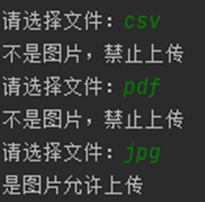
1.4 isalpha(), isdigit(),join(),lstrip(),rstrip(),strip(),split(),count()方法
#isalpha() 是否是字母,如果字符串至少有一个字符并且所有字符都是字母则返回 True,否则返回 False。
# isdigit()是否是数字,如果字符串只包含数字则返回 True 否则返回 False。
#join 方法用于将序列中的元素以指定的字符连接生成一个新的字符串。
#lstrip() 方法用于截掉字符串左边的空格或指定字符。
#rstrip() 删除 string 字符串末尾的指定字符,默认为空白符,包括空格、换行符、回车符、制表符。
# strip():方法用于移除字符串头尾指定的字符(默认为空格或换行符)或字符序列。
#split() 切割字符串
#count(args)字符串中指定args个数
1 s='abcd6' 2 3 result=s.isalpha() 4 5 print("%s---s.isalpha()="%s,result)#是否是字母

1 m='1235' 2 3 result=m.isdigit()#是否是数字 4 5 print("%s---m.isdigit()="%m,result)

1 #循环3次,判断是否是数字 是就累加 2 3 sum=0 4 5 for i in range(3): 6 7 num=input('请输入数字:') 8 9 if num.isdigit(): 10 11 num=int(num) 12 13 sum+=num 14 15 print(sum)
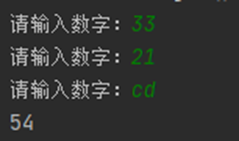
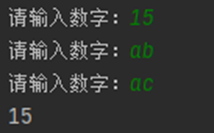
1 #循环4次,判断是否是数字 是就累加,步长加一,不是就打印不是数字,并且步长不增加, 2 3 sum=0 4 5 i=0 6 7 while i<=3: 8 9 num=input("请输入数字:") 10 11 if num.isdigit(): 12 13 num=int(num) 14 15 sum+=num 16 17 print('第{}个数字累加成功'.format(i)) 18 19 i+=1 20 21 else: 22 23 print('不是数字') 24 25 print('sum=',sum)

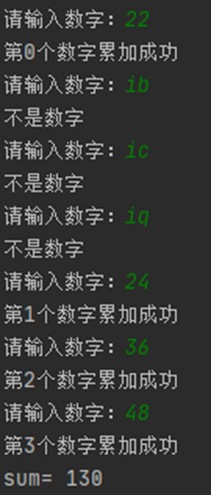
1 new_str='.'.join('abc')#用于将序列中的元素以指定的字符连接生成一个新的字符串。 2 3 print("abc---'.'.join('abc')",new_str) 4 5 list_c=['a','c','9','7'] 6 7 result=''.join(list_c)#用于将序列中的元素以指定的字符连接生成一个新的字符串。 8 9 print("['a','c','9','7']---''.join(list_c)",result)

1 s=' 天亮 ' 2 3 s=s.lstrip() #去除字符串左侧的空格 4 5 print(s+'q') 6 7 s=s.rstrip()#去除字符串右侧的空格 8 9 print(s+'y') 10 11 s=s.strip()#去除字符串两侧的空格 12 13 print(s+'5')
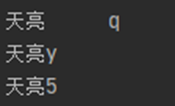
1 str = "88888888this is string example....wow!!!8888888"; 2 3 res=str.lstrip('8')#去除字符串左边的8 4 5 print ("%s---str.lstrip('8')="%str,res)

1 random_string = 'this is pencli ' 2 3 res=random_string.rstrip(' ilc')#去除空格ilc这几个字符不论顺序 4 5 print("%s---random_string.rstrip(' ilc')"%random_string,res) 6 7 res=random_string.rstrip(' cli') #去除空格ilc这几个字符不论顺序 8 9 print("%s---random_string.rstrip(' cli)"%random_string,res)

1 # 'm/' 是尾随字符,没有找到 '.' 号的尾随字符, 'm/' 从字符串中删除 2 3 website = 'www.runoob.com/' 4 5 res=website.rstrip('m/.') 6 7 print("%s\t website.rstrip('m/.')="%website,res)

1 # 移除逗号(,)、点号(.)、字母 s、q 或 w,这几个都是尾随字符 2 3 txt = "banana,,,,,ssqqqww....." 4 5 x = txt.rstrip(",.qsw") 6 7 print("%s--- txt.rstrip(\",.qsw\")="%txt,x)

1 # 删除尾随字符 * 2 3 str = "*****this is string example....wow!!!*****" 4 5 res=str.rstrip('*') 6 7 print ("%s---str.rstrip('*')"%str,res)

1 str = "00000003210Runoob01230000000"; 2 3 res=str.strip( '0' ); # 去除首尾字符 0 4 5 print ("%s---str.strip( '0' )="%str,res)

1 str = "123abcrunoob321" 2 3 res=str.strip( '12' ) # 字符序列为 12 4 5 print ("%s---str.strip( '12' )="%str,res)

1 #split() 2 3 s='one two every go' 4 5 result=s.split(' ') 6 7 print("%s---s.split(' ')"%s,result) 8 9 result=s.split(" ",2) #表示按照空格作为分隔符,分隔字符串2次 10 11 print("%s---s.split(' ',2)"%s,result)

1 str = "Google#Runoob#Taobao#Facebook" 2 3 # 第二个参数为 1,返回两个参数列表 4 5 res=str.split("#", 1) 6 7 print("%s---str.split(\"#\", 1)="%str,res)

1 s='no body see' 2 3 result=s.count(' ')#字符串中指定空格个数 4 5 print("%s---s.count(' ')"%s,result)

1 s='hello liliy how are you gril' 2 3 result=s.count('l')#字符串中指定l个数 4 5 print("%s---s.count('l')"%s,result)

1 str = "this is string example....wow!!!"; 2 3 res=str.count('i', 4, 40) 4 5 print("%s---str.count('i', 4, 40)="%str,res)





【推荐】国内首个AI IDE,深度理解中文开发场景,立即下载体验Trae
【推荐】编程新体验,更懂你的AI,立即体验豆包MarsCode编程助手
【推荐】抖音旗下AI助手豆包,你的智能百科全书,全免费不限次数
【推荐】轻量又高性能的 SSH 工具 IShell:AI 加持,快人一步
· 震惊!C++程序真的从main开始吗?99%的程序员都答错了
· 别再用vector<bool>了!Google高级工程师:这可能是STL最大的设计失误
· 【硬核科普】Trae如何「偷看」你的代码?零基础破解AI编程运行原理
· 单元测试从入门到精通
· 上周热点回顾(3.3-3.9)